They’re all here from sausages based on different meat products, cured and smoked sausages, and even vegan sausages.
The word sausage dates back centuries, originally coming from the Latin word for salted: ‘salsus’ (1).
But it’s interesting that the first written record of sausages was from 4,000 years ago in Mesopotamia, where a dish made with meat and intestine casings was mentioned.
Since that time, sausages have become a popular food around the world. Furthermore, most countries and even regions have their own varieties.
In this guide, we will look at some different types of famous sausages from around the world.
For each sausage variety, you can see information on its origin, type, nutritional values, and general characteristics. Because each sausage is a different size, the nutritional information is given “per 100 grams” so that it is easy to compare.
Unless otherwise stated, the data source for nutritional values is the USDA’s FoodData Central database.
Percent daily values (% DV) have been calculated using the FDA’s published daily values.
Fresh beef sausages are popular worldwide, particularly in Germany, Poland, the United Kingdom, and the United States.
Here are the typical nutritional values for cooked beef sausages per 100 grams (3):
Some Berliner products may also include liver, and the sausage typically has a high salt content.
Per 100 grams, the typical nutritional profile for Berliner sausage is as follows (4):
Beyond Sausage is a plant-based vegan alternative to traditional sausages launched in June 2023 (5).
Pea protein, oils, and different flavorings are mixed together to try to make it taste and feel like a traditional meat sausage.
Beyond Sausage is high in protein and has about the same amount of fat as low-fat pork and beef sausages.
See this article for a full list of Beyond Sausage’s nutrients and how it stacks up against regular sausages:
Around the world, blood sausage comes in many different forms, such as “black pudding” in the UK, boudin noir in France, blodkorv in Sweden, and sundae in Korea.
It can sometimes have pork or lamb in it, and the sausages are made with salt, vinegar, and a mix of herbs and spices. Vinegar gives boerewors a unique flavor characteristic compared to other sausages.
Based on the NCC Food and Nutrient Database, here are the health benefits of 100 grams of cooked boerewors (8):
The USDA database only has data for raw, uncooked bockwurst, shown below per 100 grams (9).
Chorizo is a popular dry, fermented, and cured sausage from Spain that can be eaten uncooked.
However, with hundreds of chorizo varieties, this isn’t always the case. Some may be smoked and cooked, while others may be fresh and require cooking.
This makes it essential to carefully check the label of any chorizo products concerning any preparation requirements.
Chorizo’s bright red color comes from the smoked paprika that’s in it. The sausage is chewy and tastes a little spicy.
Originating in the city of Frankfurt, Germany, frankfurters are perhaps more famously known as ‘hot dogs.’
Frankfurters usually have pork as the main ingredient, but they can also have chicken, beef, or even a mix of the three. Frankfurters typically contain sodium nitrate and/or sodium nitrite as preservatives.
For many home cooks and sausage lovers, picturing food weights can be challenging. When a recipe calls for 100 grams of sausage, what should that quantity actually look like on your plate or prep area? This helpful guide provides a visual reference for 100 grams of sausage, using photos and everyday comparisons to give you an accurate mental image.
Why Visualize 100 Grams of Sausage?
Visualizing food weights is an invaluable kitchen skill for several reasons
- Provides portion control for recipes and meal planning
- Allows you to shop efficiently by estimating amounts at a glance
- Helps compare nutritional information across different sausage types
- Gives you a better sense of value when purchasing sausages by weight
- Allows you to quickly divide sausages into equal portions for recipes or sharing
For such a versatile and popular food item, having a clear visual cue for 100 grams of sausage makes cooking with it much more intuitive.
What Does 100 Grams of Sausage Look Like?
So what should you envision when a recipe calls for 100 grams of sausage? Here are some approximations using different sausage varieties
Pork Breakfast Sausage
- 1 average pork breakfast sausage link
- A 3.5 inch section of sausage from a chub
- Approximately the size of a small banana
Italian Pork Sausage
- 2 average sweet or hot Italian sausage links
- A 4 inch section of bulk Italian sausage from a chub
- Roughly the size of a small apple
Bratwurst
- 1 average bratwurst link
- A 3 inch section of bratwurst from a chub
- Similar in size to a large carrot
Andouille Sausage
- 1 average andouille sausage link
- A 2.5 inch section of andouille from a chub
- Approximately the length of a TV remote
Chorizo Sausage
- 2 average fresh chorizo sausages
- A 3 inch section of chorizo from a chub or tube
- Comparable to a medium plum tomato
Kielbasa
- 1 average kielbasa sausage link
- A 4 inch section of kielbasa from a chub
- Similar in size to a large zucchini
Cocktail Sausages
- 5-6 average cocktail sausages
- About enough to cover the palm of an average adult hand
Handy Visual Cues
Beyond links and chubs, here are some other handy visual comparisons for 100 grams of sausage:
- A hockey puck
- A medium chicken egg
- A light bulb
- Half a cup of chopped sausage
- A standard deck of playing cards
- A medium banana
Tips for Measuring Sausage
If you don’t have a kitchen scale, use these tips to estimate sausage amounts:
- Check the package for average link weights as a reference
- Note the grams per inch listed on chubs of sausage
- Weigh a sample sausage on a diet or postal scale
- Use your hands as a guide (palm size, finger widths)
- Compare to common household objects of known weight
With some practice, visualizing 100 grams of sausage will become second nature. You’ll whip up perfect portions for any recipe with ease. So next time a recipe calls for 100 grams of sausage, you’ll know just how much to grab.

Reduced Fat Sausage Varieties
In addition to regular beef and pork sausages, it is also possible to buy common reduced-fat varieties.
These low-fat options have a lower fat and overall calorie provision and correspondingly higher protein content. Because of this, they might be a good choice for people who want to cut back on calories or saturated fat.
They could also be a good choice for increasing dietary protein intake.
Kielbasa (kielbasa Polska)
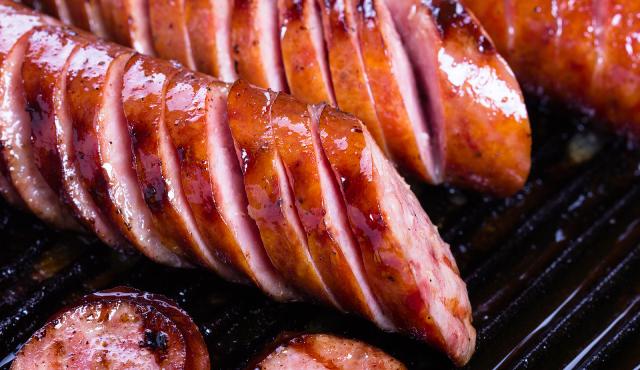
- Origin: Poland
- Type: cooked smoked
- Main ingredients: pork, beef, salt, garlic, various herbs and spices
Kielbasa means ‘sausage’ in Polish, and many different types of kielbasa (or sausage) exist in Poland. Some varieties may be fresh, and others could be pre-cooked or smoked.
However, ‘kielbasa’ typically refers to a smoked and pre-cooked sausage known as ‘kielbasa Polska.’
Since this sausage has been pre-cooked, it must only be reheated before consumption.
If it is kielbasa Polska (the pre-cooked kind), you can eat it without cooking it. But make sure you read the label carefully to be sure.
100 grams of cooked kielbasa provides the following nutritional profile (12):
- Calories: 337 kcal
- Carbohydrates: 5.03 g (2% DV)
- Fiber: 0 g (0% DV)
- Sugars: 2.39 g
- Fat: 29.7 g (38% DV)
- Saturated: 9.89 g (49% DV)
- Monounsaturated: 12.6 g
- Polyunsaturated: 5.38 g
- Protein: 12.4 g (25% DV)
- Cholesterol: 73 mg (24% DV)
- Sodium: 1060 mg (46% DV)
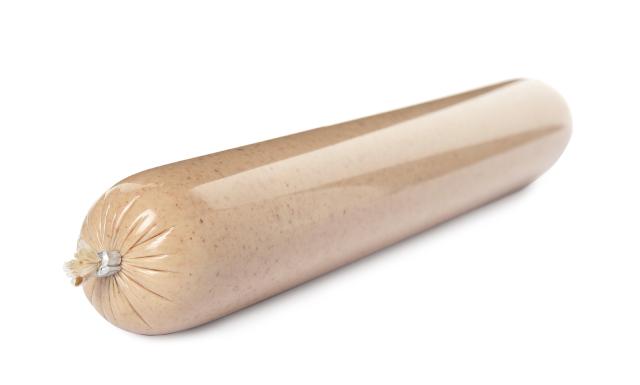
- Origin: Germany
- Type: cooked
- Main ingredients: liver, meat, fat, herbs and spices
Liverwurst is a German sausage containing liver, usually mixed with meat, fat, herbs, and spices.
As a pre-cooked sausage, it is ready to eat and available to buy in ‘firm’ and ‘spreadable’ varieties.
There are a lot of micronutrients in liverwurst, but it is also high in fat and calories. For more information, see this guide to liverwurst nutrition.
Here are the nutritional values per 100 grams of spreadable liverwurst (13):
- Calories: 305 kcal
- Carbohydrates: 5.89 g (2% DV)
- Fiber: 2.5 g (9% DV)
- Sugars: 1.65 g
- Fat: 25.4 g (33% DV)
- Saturated: 9.92 g (50% DV)
- Monounsaturated: 12.3 g
- Polyunsaturated: 2.43 g
- Protein: 12.4 g (25% DV)
- Cholesterol: 118 mg (39% DV)
- Sodium: 700 mg (30% DV)
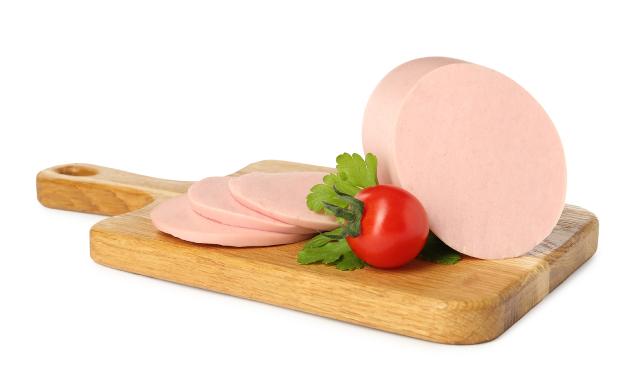
- Origin: United States
- Type: cooked
- Pork, beef, fat, flour, sugar, herbs and spices, sodium nitrate and/or sodium nitrite are the main things that go into it.
Luncheon sausage is a sausage-shaped variety of luncheon meat originating in the United States.
It can either be bought as a large sausage or, more commonly, sold in ready-sliced form.
Luncheon sausage has been pre-cooked and is ready to eat at the point of sale.
Each 100 grams of luncheon sausage typically offers the following nutritional values (14):
- Calories: 260 kcal
- Carbohydrates: 1.58 g (<1% DV)
- Fiber: 0 g (0% DV)
- Sugars: –
- Fat: 20.9 g (27% DV)
- Saturated: 7.62 g (38% DV)
- Monounsaturated: 9.93 g
- Polyunsaturated: 2.05 g
- Protein: 15.4 g (31% DV)
- Cholesterol: 64 mg (21% DV)
- Sodium: 1180 mg (51% DV)
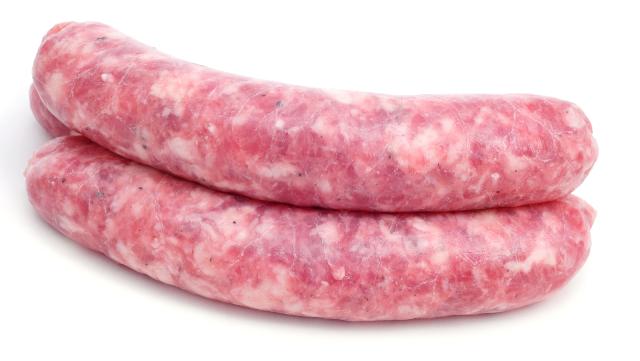
- Origin: Spain
- Type: fresh
- Salt, pepper, garlic, nutmeg, and sometimes vinegar and paprika are added to the pork.
Longaniza is a traditional fresh Spanish sausage that must be cooked before eating. In traditional Spanish cooking, black pepper is the main spice. In other countries, there are different kinds of pepper.
For instance, longaniza is also popular in Spanish-speaking countries like Argentina, Chile, Mexico, Peru, and Uruguay. Each of these countries has its own way of seasoning longaniza, some being spicy and others milder.
Using data from the NCC Food and Nutrient Database, here are the nutritional values for cooked longaniza per 100 grams (8):
- Calories: 271 kcal
- Carbohydrates: 2.86 g (1% DV)
- Fiber: 1.43 g (5% DV)
- Sugars: 0 g
- Fat: 24.29 g (31% DV)
- Saturated: 8.57 g (43% DV)
- Monounsaturated: –
- Polyunsaturated: –
- Protein: 12.86 g (26% DV)
- Cholesterol: 64.29 mg (21% DV)
- Sodium: 857 mg (37% DV)
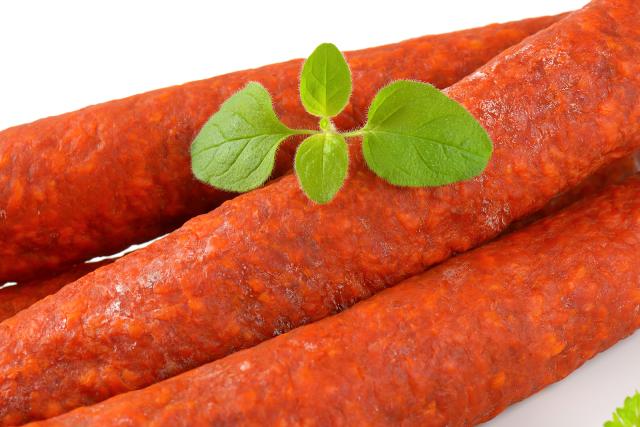
- Origin: United States
- Type: dry
- Pork, beef, fat, salt, paprika, spices, sodium nitrate and/or sodium nitrite are the main things that go into it.
Despite common presumptions of Italian origin, pepperoni first appeared in Italian-American markets in the United States in the early 20th century (15).
Pepperoni is a cured, dried sausage and has not been cooked. It is ready to eat at the point of sale.
Among its many culinary uses, pepperoni is among the most popular pizza toppings.
Nutritionally, every 100 grams of pepperoni has the following values (16):
- Calories: 504 kcal
- Carbohydrates: 1.18 g (<1% DV)
- Fiber: 0 g (0% DV)
- Sugars: 0 g
- Fat: 46.3 g (59% DV)
- Saturated: 17.7 g (89% DV)
- Monounsaturated: 20.8 g
- Polyunsaturated: 4.46 g
- Protein: 19.2 g (38% DV)
- Cholesterol: 97 mg (32% DV)
- Sodium: 1580 mg (69% DV)
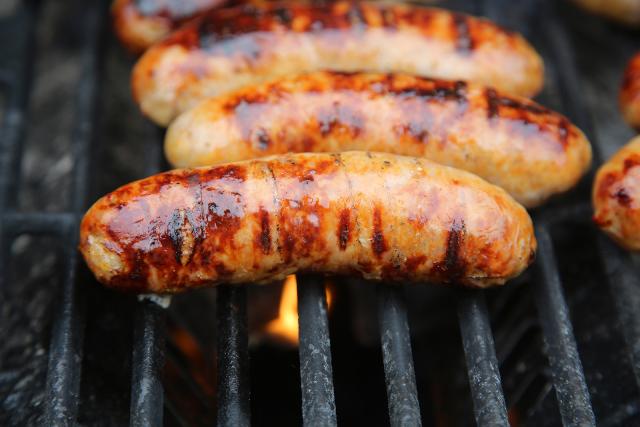
- Origin: multiple countries
- Type: fresh
- Main ingredients: pork, herbs, spices, sometimes flour, salt
A typical fresh pork sausage may also be known by names such as ‘banger’ and ‘breakfast sausage.’
These sausages contain a primary ingredient of fresh, raw pork alongside varying herbs and spices, and salt. Some sausages may also have a small amount of flour added to them to make them thicker and stick together better.
A typical cooked pork sausage has the following nutritional values per 100 grams (17):
- Calories: 325 kcal
- Carbohydrates: 1.42 g (<1% DV)
- Fiber: 0 g (0% DV)
- Sugars: 1.09 g
- Fat: 27.2 g (35% DV)
- Saturated: 8.83 g (44% DV)
- Monounsaturated: 11.5 g
- Polyunsaturated: 5.12 g
- Protein: 18.5 g (37% DV)
- Cholesterol: 86 mg (29% DV)
- Sodium: 814 mg (35% DV)
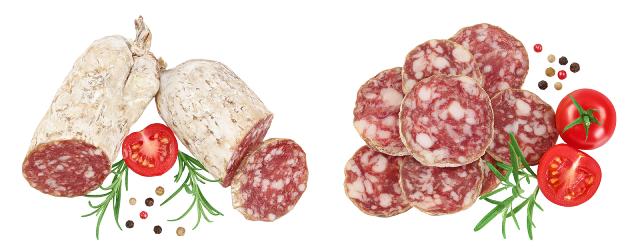
- Origin: Italy
- Type: dry
- Pork, beef, salt, pepper, herbs and spices, sodium nitrate and/or sodium nitrite are the main things that go into it.
Originating in Italy, salami is a fermented, cured dry sausage usually made from pork. However, some salami products may use beef or a combination of the two.
Salami can take weeks to several months to produce, depending on the product.
As with other dried sausages, salami contains much higher fat and calories (and overall nutrients) than fresh sausages. Per 100 grams, pork salami has the following nutritional values (18):
- Calories: 425 kcals
- Carbohydrates: 1.2 g (<1% DV)
- Fiber: 0 g (0% DV)
- Sugars: 1.2 g
- Fat: 37 g (47% DV)
- Saturated: 13.1 g (66% DV)
- Monounsaturated: 18.2 g
- Polyunsaturated: 3.6 g
- Protein: 21.7 g (43% DV)
- Cholesterol: 80 mg (27% DV)
- Sodium: 1890 mg (82% DV)

- Origin: multiple countries
- Type: fresh
- Main ingredients: turkey, salt, spices, sometimes flour
Fresh turkey sausages, which are a type of “breakfast sausage” or “banger,” look a lot like fresh pork and beef sausages.
However, they have a milder taste and a lower fat (and calorie) content. Nutritionally, they are also a richer source of protein.
Some people think that turkey sausages are “healthier” than traditional pork and beef sausages because they have more nutrients.
Cooked turkey sausages provide the following typical nutritional profile per 100 grams (19):
- Calories: 196 kcal
- Carbohydrates: 0 g (0% DV)
- Fiber: 0 g (0% DV)
- Sugars: 0 g
- Fat: 10.4 g (13% DV)
- Saturated: 2.27 g (11% DV)
- Monounsaturated: 2.99 g
- Polyunsaturated: 2.71 g
- Protein: 23.9 g (48% DV)
- Cholesterol: 92 mg (31% DV)
- Sodium: 665 mg (29% DV)
Find out more: Are Turkey Sausages a Healthy Choice?
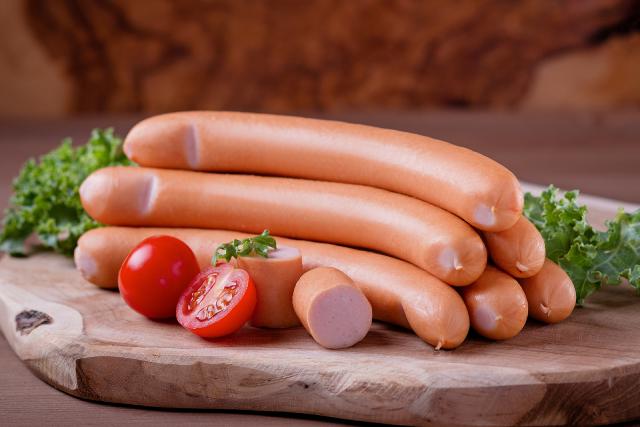
- Origin: Austria
- Type: cooked smoked
- Pork, beef, chicken, herbs and spices, salt, sodium nitrate and/or sodium nitrite are the main things that go into it.
Alongside Frankfurters, the Vienna sausage is another sausage used as a ‘hot dog.’
Most of the time, pork is the main ingredient, but beef, chicken, turkey, or a mix of these can also be used.
After grinding the meat into a paste, it is combined with salt, herbs, and spices before entering the sausage casing (20).
As Vienna sausages are pre-cooked, they can be consumed straight from the packet. However, most people recook them before eating.
Vienna sausages provide the following nutritional profile per 100 grams (21):
- Calories: 230 kcal
- Carbohydrates: 2.6 g (1% DV)
- Fiber: 0 g (0% DV)
- Sugars: 0 g
- Fat: 19.4 g (25% DV)
- Saturated: 7.12 g (36% DV)
- Monounsaturated: 9.63 g
- Polyunsaturated: 1.29 g
- Protein: 10.5 g (21% DV)
- Cholesterol: 87 mg (29% DV)
- Sodium: 879 mg (38% DV)
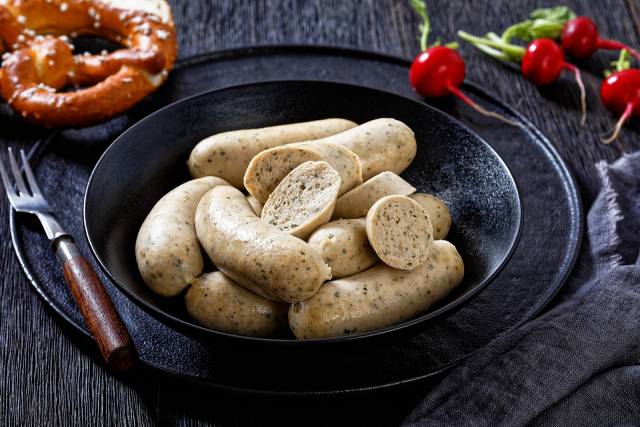
- Origin: Germany
- Type: fresh
- Back bacon, veal, salt, parsley, lemon zest, and other herbs and spices are the main things that go into it.
‘Weisswurst’ is a fresh German sausage that translates to English as ‘white sausage.’
Veal tends to have a lighter color than pork or beef, so the sausage has a white appearance.
Also, weisswurst doesn’t have any sodium nitrate or sodium nitrite in it, which give food a pink color when they’re cooked. Therefore, this white sausage keeps its pale characteristics during and after cooking.
A typical weisswurst sausage has the following nutritional profile per 100 grams (22):
- Calories: 283 kcal
- Carbohydrates: 1.77 g (<1% DV)
- Fiber: 0 g (0% DV)
- Sugars: 0 g
- Fat: 26.6 g (34% DV)
- Saturated: 8.85 g (44% DV)
- Monounsaturated: –
- Polyunsaturated: –
- Protein: 10.6 g (21% DV)
- Cholesterol: 53 mg (18% DV)
- Sodium: 646 mg (28% DV)
What Does 100g Of Protein Looks Like In Different Foods
FAQ
How much sausage is 100g?
How many grams is 1 piece of sausage?
|
Food
|
Serving
|
Serving
|
|
Salami 1 slice (17 g)
|
100 g
|
1 slice (17 g)
|
|
Sausage 1 piece (75 g)
|
100 g
|
1 piece (75 g)
|
|
Sausage Roll 1 piece (71 g)
|
100 g
|
1 piece (71 g)
|
|
Serrano Ham 1 slice (14 g)
|
100 g
|
1 slice (14 g)
|
How much do 100 grams of meat look like?
How many grams is 2 sausages?
|
Typical Values
|
Per 100g
|
2 sausages (92g**)
|
|
Fibre
|
1.0g
|
0.9g
|
|
Protein
|
16.6g
|
15.3g
|
|
Salt
|
1.30g
|
1.20g
|
|
* Reference intake of an average adult (8400 kJ / 2000 kcal)
|
–
|
–
|
